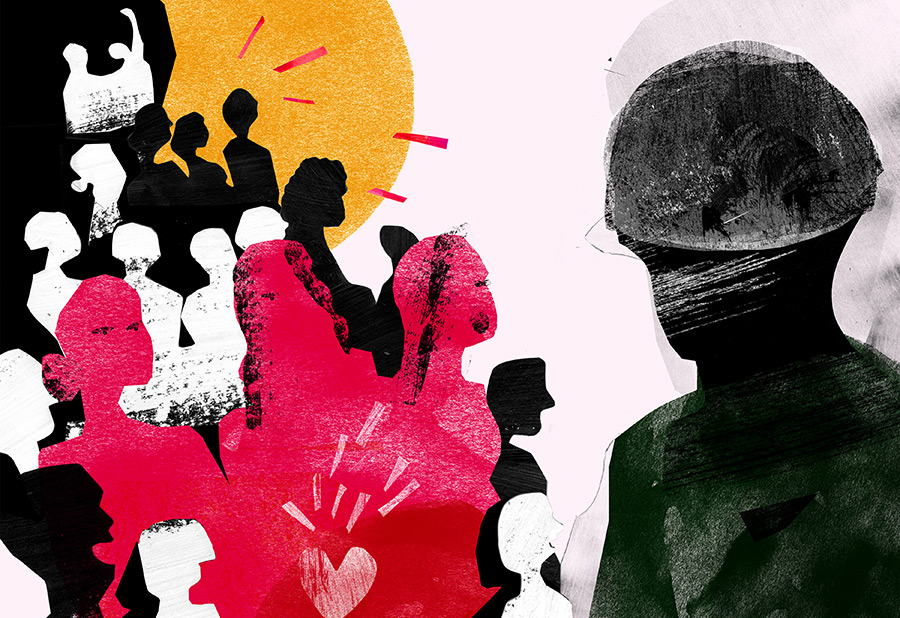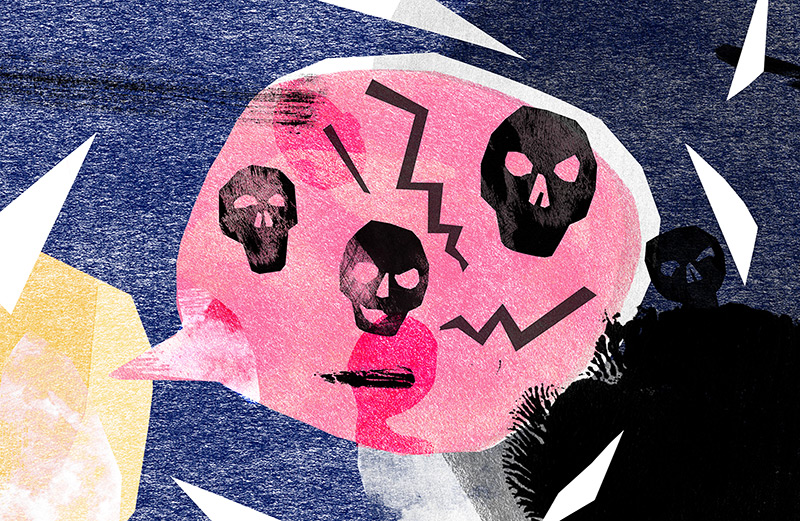Grasping Hate
By Linda Kinstler ’13Hatred is not new. But it has felt weighty and present in this moment in our lives, and the need to understand and grasp its roots and meaning has felt deeply urgent.
Bowdoin faculty study and share with their students the reasons for and results of hate, the sources of and possible solutions to our deep divisions, and ways to contextualize and understand this extreme and destructive emotion in history and in ourselves—in order to move away from its violence, toward virtue.
Early this spring, a curious envelope with my name stamped on it in bold black letters arrived in the mail. The return address indicated that it had been sent to my home in Washington, DC, by the Southern Poverty Law Center (SPLC), in Montgomery, Alabama, a nonprofit legal advocacy firm dedicated to protecting civil rights. I had been selected to participate in their “2021 Fighting Hate in America National Survey,” a nationwide poll designed to help the SPLC figure out “how to overcome the hate, racism, white supremacy, and intolerance that is poisoning our country.” A map of 838 active hate groups in the US in 2020 accompanied the survey. Each group was labeled according to its specific brand of rancor: anti-immigrant, anti-Muslim, anti-Semitic, anti-LGBTQ, white nationalist, and “general hate” groups. The map showed them clustering around cities east and west: San Francisco, Los Angeles, Tampa, New York, DC.
The survey asked me to answer a series of multiple-choice questions about my experiences of hatred: “Have you ever observed hate group activity in your community?” “Have you or a family member been a victim of a hate crime?” “Are there any Confederate monuments or public buildings or streets named after Confederate leaders in your community?” “Would you participate in a boycott of internet companies that refuse to stop racists from using their platforms to organize, raise money, and poison the minds of children?” Did I think social media companies were doing enough to combat hate online? Did I think they should be subject to stricter regulations? Did I want the federal government to do more to investigate hate groups in the US?

These are some of the most pressing questions of our time: Why is there so much hatred, and what can we do to mitigate it? Who should be held accountable for its spread? How do we acknowledge and mark the horrors of the past while also building toward an equitable future? Open the newspaper or switch on the television, and invariably these questions will be broached. Over the past several years, I have engaged with these issues in conversations with colleagues, students, and friends. I have interviewed social media executives about their efforts to remove hate speech from their platforms. At Berkeley, I helped convene a conference on our new memorial culture, where architects and scholars presented ideas about how to preserve the relics of our nation’s dark past once they have been removed from their pedestals, and what kinds of public monuments should be erected in their place. Concrete, actionable solutions were few and far between, and hateful incidents continued to disrupt public life across the country. On January 6, I watched as rioters slowly made their way back from the US Capitol, some of them carrying Confederate flags over their shoulders, many of them clad in military camouflage. It was a terrible day for the nation, and a grave indicator of just how wide and deep the hatred runs.
Hatred is an intractable problem in part because it is so difficult to describe. David Hume said that it is “altogether impossible to define.” The Stoics described hatred as “a desire for something bad to happen to another, progressively and continually.” Aristotle, in On Rhetoric, defines hate only by what it is not: it is not philia, meaning love or friendship, and it is not anger or spite, which, he wrote, “derives from what happens to oneself.” He saw that while anger is directed at individuals, hatred is directed at entire groups and categories of beings. Anger would heal over time, but hatred was “incurable”—violent and unfeeling, forever. In ancient Greek, the verb ekhthairô, “to hate,” is linked to ekhthros, the word for personal enemy. To inquire into the roots of hatred, then, requires probing the impulses, imaginations, and desires that draw people together and pull them apart and asking what pushes people to categorize individuals and groups as friends or enemies.
Bowdoin students, faculty, staff, and alumni have been hard at work doing precisely that across a variety of fields. The past several years have made it abundantly clear that we are facing a critical moment for global democracy, a time of unprecedented challenges and rising hatreds. The faculty has risen to the moment in a variety of ways, putting together new courses on race and identity politics, the origins and mutations of discrimination in ancient and modern times, and the fault lines of hatred in the US and Asia, South America, the Middle East, and more.
If it is true, as the Roman philosopher Seneca claimed, that “the liberal arts do not conduct the soul all the way to virtue, but merely set it going in that direction,” then these new curricular additions and research areas are aimed toward that end.
A Bowdoin education is designed to attune students to the awesome, inspiring, and sometimes dangerous powers of discourse.
No matter what language or alphabet students work with, or whether they become fluent in mathematical equations, computer algorithms, or Chinese script, they must learn about the ways that biases, stereotypes, and blind spots can worm their way into their work.
Professor Krista Van Vleet, chair of the anthropology department, has for many years asked students in her course Language, Identity, and Power to participate in an exercise designed to do just that. “One of the things that I have students do is record an everyday conversation. Ask permission, record, and then go back and analyze the ways in which people are talking. Even if they’re not explicitly talking about race or gender, sometimes they’re able to pick up on the ways in which those identities are being mobilized in a conversation,” Van Vleet explained. We tend to take the language of the everyday for granted, skipping over its nuances, inflections, and unarticulated assumptions. Her students are asked to parse their everyday interactions, to analyze the subtext and context of their own speech. They are amazed, she said, by what they come to hear in their own words. “What does a microaggression actually look like as it’s in play? What about a joke? Sometimes jokes rely on unspoken stereotypes,” said Van Vleet. “Helping students see that helps move us toward dismantling it, so that people can become a little bit more comfortable interrupting a conversation, or perhaps moving it in a different direction, if they become aware of the ways in which these implicit assumptions might be playing out.”
Anthropology is an exercise in making the strange familiar, and the familiar strange. The discipline, Van Vleet says, “is continually pressing us to recognize the ways in which we are all embedded in these systems of oppression. Even as we recognize them, and try to dismantle them, we are still a part of these cultural assumptions.”
Across campus, in Kanbar Hall, Assistant Professor of Psychology Zachary Rothschild researches how even subtle changes in the framing of political issues can stoke and stymie hatred, how efforts to create neat categories and to identify scapegoats can worsen social divisions. “We are really motivated by a fundamental need to see ourselves as good people, as part of a meaningful, coherent world,” Rothschild said. “When bad things happen, it’s a threat.” Pandemics, plagues, famines, and all kinds of disasters have, throughout history, led political leaders to try to restore order by pointing fingers. Identifying a scapegoat, Rothschild explained, can allow violence and vitriol to masquerade as a moral good. “I’ve been doing a lot of research lately on moral outrage, about what happens when we experience anger when people do wrong, or act unjustly, and understanding that oftentimes the things we do in the name of justice may be motivated by our own moral concerns,” he said.
Remind someone of their own wrongdoing, and they become more likely to punish others for doing wrong. His recent research suggests that some people experience hatred as a profound source of meaning: “It’s an expression of their beliefs, values, and justice—they feel that they are doing a good thing,” said Rothschild. “People actually can feel more meaning in their own lives by expressing hostility at perceived wrongdoing.”
Just as psychology can help diagnose the source of the problem, it can also help identify solutions. Rothschild’s research suggests that expressions of affirmation and opportunities for constructive reflection can mollify the spread of hatred and its corrosive effects. If you “boost their sense of value or control,” people need to lash out less, he argues. In one experiment, Rothschild asked subjects to reflect on what makes them a good person, about the ways large and small that they are good to others and to their communities. “The idea is just to reaffirm their belief that, ‘I am a good person. I don’t need to compensate by lashing out at these other people to prove that I am good.’” In another instance, prompting participants to consider the chaotic and uncontrollable nature of the world mitigated feelings of hostility. “If the underlying problem really is a threat to the fundamental need for control, for a positive identity, then if I can attenuate those threats in other ways, I can reduce the need to resort to scapegoating or outrage,” he explained.
But opportunities and avenues for critical reflection—moments when individuals are invited to consider their relationships to others, to history, and to themselves—can be few and far between. In the spring of 2020, amid an uptick in anti-Semitic violence in the US and around the world, English professor Marilyn Reizbaum and religion professor Todd S. Berzon teamed up to offer a new course, A History of Anti-Semitism. It would be a nonlinear history, an exploration of anti-Semitism’s appearances in film, tragedy, dialogue, and scripture, and an attempt to trace its mutations and contexts across the centuries. The class investigated manifestations of anti-Semitism and responses to it in works ranging from the Bible to Shakespeare’s Merchant of Venice to Larry David’s sitcom Curb Your Enthusiasm. “In many of the courses I teach, I regularly assign students texts from the ancient world that can only be described as anti-Jewish. Students would always engage with the text seriously and carefully, and would invariably draw connections to more modern discourses of anti-Semitism,” Berzon explained. “It was the students, and their desire to see how these ideas unfolded across history, that led me to propose a stand-alone course dedicated to the topic.” Reizbaum added that the course arose from a desire to acknowledge and respond to a critical moment in culture and politics and to allow students to reflect on the origins of hatreds past and present. After the COVID-19 pandemic forced the course to transition online midway through the semester, current events interceded into the classroom in new and forceful ways.

In the history department, Assistant Professor Sakura Christmas takes a similarly long-term view of the evolution of cultures of exclusion and racial difference. Her first book investigates ethnic determinism and Japanese-led ethnic cleansing in Inner Mongolia and how the Japanese imperial project produced a narrow understanding of ethnicity, autonomy, and belonging. Before she began her PhD, Christmas spent a year teaching English as a Princeton-in-Asia fellow, working with students in the Xinjiang Uyghur Autonomous region, where it is now estimated that more than a million Uyghurs have been interned in Chinese government-run detention centers.
“It was a phenomenal experience, but it was also a really tragic one, in the sense that I experienced firsthand the kind of structural racism that was already built into the system in 2008 and 2009, well before the internment camps that were built two or three years ago,” Christmas said. She saw how her friends and acquaintances were forced into bilingual education and were shut out of particular disciplines, departments, and economic opportunities because they were Uyghur. “The groundwork was already there, in terms of ideology. You just needed to add the infrastructure,” she said. At Bowdoin, she teaches courses in environmental history and on power and territory in Asia, exploring the origins and causes of the racial and economic hierarchies and extractive logics that define the region. On several occasions, the classroom conversation has turned to the contemporary crisis in Xinjiang, a conversation that the realities of remote instruction have made more difficult than ever before.
“We’re all on Zoom this year, and I always teach a number of students from mainland China. I understand, to a certain extent, how Chinese surveillance works—I have a big file, myself—so I have found it very difficult to broach these sensitive subjects in a way that might have endangered them.” Students based in China may not know the extent to which they are being surveilled, and as a result may find themselves having to make difficult decisions about which conversations to participate in, and which ones to be absent for. “It’s been really difficult,” said Christmas. She has avoided engaging in conversations that might jeopardize her students abroad in any way. “Having been surveilled myself when I lived in China, almost fifteen years ago, I know that the surveillance mechanisms have only gotten more sophisticated since then.” The very conditions and power relations she teaches in the classroom have presented themselves in the classroom.
Even when the pandemic finally recedes and Zoom meetings are more a convenience than a necessity, we will still have to reckon with the fact that our reliance upon technology as a primary method of communication has exacerbated and accelerated the spread of hatred both online and off. For the past several decades, Christopher Wolf ’76, senior counsel emeritus at the law firm Hogan Lovells, has dedicated himself to combating the spread of hate speech online and working with governments and technology companies to come up with actionable solutions. In the early days of the internet, he decided to volunteer with the Anti-Defamation League (ADL), which monitors the spread of extremism and hate of all kinds. “We discovered that extremists and haters were early adopters of technology,” Wolf explained. They used dial-up networks to coordinate activity and manipulated static webpages to advance discriminatory beliefs.
Since then, their methods have become more sophisticated, accessibility has spread, and the velocity of online speech has hit a breakneck pace, leaving lawmakers rushing to figure out how to regulate online discourse. “Law is not the most effective tool—it is a tool, but it is not the most effective tool,” explained Wolf, a pioneer of online privacy law. “Even in countries outside of the US—where there is no First Amendment, and where free speech is not as robust and there is the ability to regulate speech—we have not seen a precipitous drop-off in hate speech.” He recently led a comprehensive, cross-jurisdictional survey of global regulations governing online hate, in partnership with the global nonprofit PeaceTech Lab. The goal was to compile existing policy remedies to hate speech in order to help governments decide which options to pursue going forward. Fernand de Varennes, UN special rapporteur on minority issues, called it an “invaluable compendium” that “suggest[s] that there is no single approach to hate speech, and quite often none specifically adapted to the particular nature and challenges of hate speech in social media.” Neither law nor language lend themselves to simplified solutions.
A few hours after we spoke, Wolf participated in a virtual workshop run by the National Academy of Sciences on the subject of potential amendments to Section 230 of the Communications Decency Act of 1996, which grants internet companies immunity from being held accountable for things that are said or written on their platforms. “The platforms have a big role to play, and also a big responsibility,” Wolf told me. “These services are becoming like public squares. They aren’t a public utility, but they’re edging very close to that. They are not common carriers; they’re a hybrid. They play multiple roles in people’s lives.”
Ultimately, Wolf thinks the problem of online hatred is not going to be solved by legal amendments, or government regulations, or more aggressive take-down policies, but by a combination of approaches. “It has to be a multipronged, collaborative effort, and it needs to start in the schools,” he said. “We do not have any standards for teaching kids how to use technological tools to protect themselves, to filter content that they’re seeing, to teach them to be better citizens. That starts at home. We need to get civil society involved, we need to get governments involved, and we need to get companies involved. Everyone has a shared responsibility.”
He feels buoyed by the unprecedented support the ADL and like-minded organizations have recently received: “It’s exciting to see the level of support for the activities of the Anti-Defamation League over the past couple of years, in the wake of the anti-immigrant movement, Black Lives Matter, and anti-Asian hatred in the wake of the coronavirus. You see a lot of people coming out and wanting society to do better,” he said.
“People are constantly saying, ‘How do I get involved?’ ‘What can I do to help?’”
Linda Kinstler ’13 is a writer and PhD candidate at UC Berkeley. Her work appears in The New York Times Magazine, The Atlantic, The Guardian, and elsewhere.
Kajsa Nilsson is an illustrator and graduate of The Royal Danish Academy of Fine Arts. She lives in Västerbotten, Sweden.

This story first appeared in the Spring/Summer 2021 issue of Bowdoin Magazine. Manage your subscription and see other stories from the magazine on the Bowdoin Magazine website.